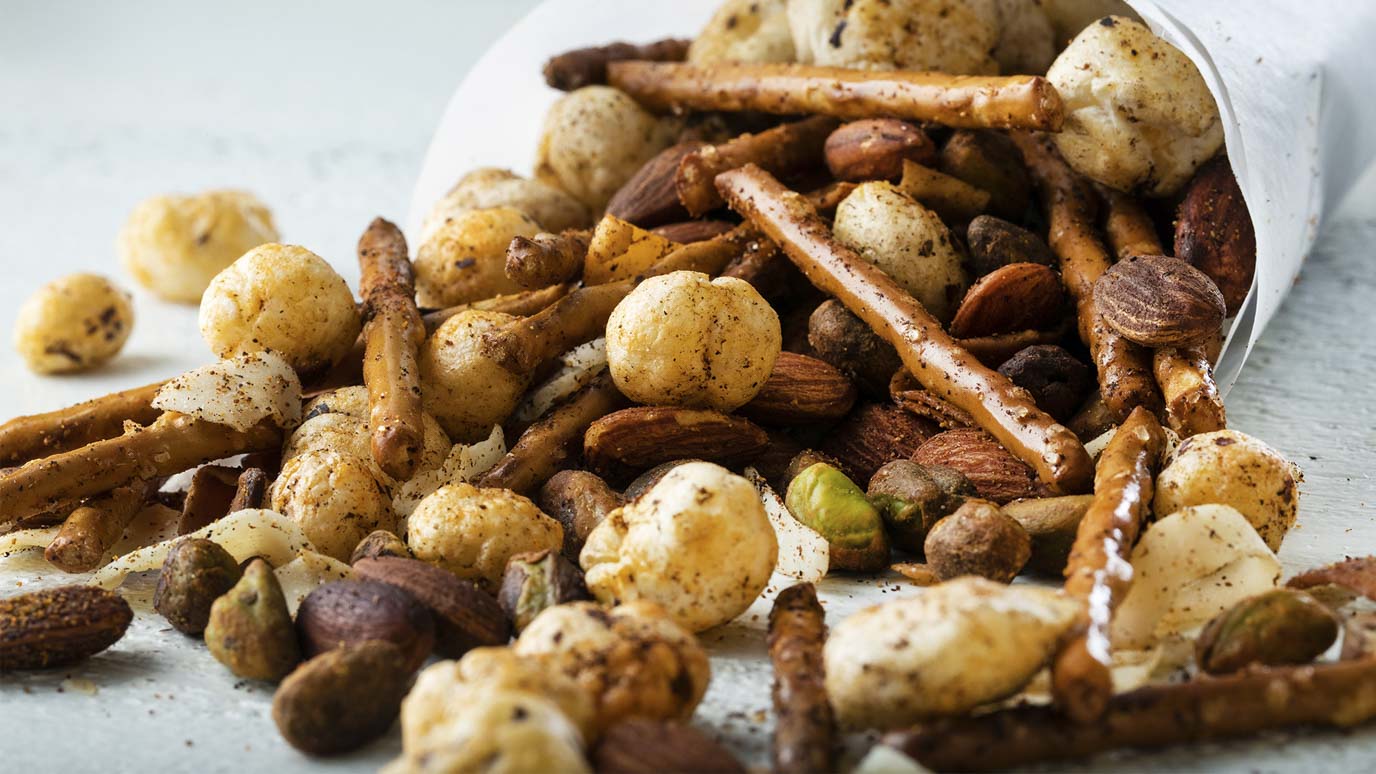15m
PREP TIME
15m
COOK TIME
9
INGREDIENTS
Ingredients
- 2 cups plus 1 tablespoon vegetable oil, divided
- 2 cups thick poha
- 1/2 cup roasted unsalted peanuts
- 30 dried curry leaves, rinsed and dried well
- 1/2 teaspoon McCormick® Ground Turmeric
- 1/4 teaspoon McCormick® Ground Cayenne Red Pepper
- 1/8 teaspoon citric acid
- 1/3 cup sugar
- 3/4 teaspoon salt
INSTRUCTIONS
- 1 Heat 2 cups (500 ml) of the oil in large deep skillet on medium-high heat until hot (about 375 to 400°F/190 to 200°C). Place a mesh strainer lined with paper towels over a large heat-safe bowl or 4-cup glass measuring cup. Add about 1/4 cup (60 ml) of poha to hot oil. Fry until poha is puffed and starts to float. Pour oil and poha through prepared strainer. Transfer poha to a paper towel-lined pan to drain. Return oil to skillet. Repeat process, working in batches, until all poha is puffed. Set poha aside.
- 2 Return oil to skillet. Heat on medium-high heat until hot. Add peanuts. Fry until golden brown. Remove from oil using slotted spoon. Set aside to drain on paper towel-lined pan. Add curry leaves to oil; fry until crisp. Remove from oil; drain well and crush. Discard oil.
- 3 Wipe skillet clean with paper towels. Heat remaining 1 tablespoon (15 ml) oil in skillet on low heat. Add puffed poha, turmeric, cayenne and citric acid, stirring to mix well. Cook just until fragrant. Remove from heat. Transfer mixture to large clean bowl. Cool completely.
- 4 Add fried peanuts, crushed curry leaves, sugar and salt. Toss until well blended. Serve immediately or store in an airtight container until ready to serve. (Makes about 5 cups.)
-
5
Test Kitchen Tips:
• Poha, also called parched rice or beaten rice, is a flavorless parboiled white rice that is flattened and dried. It is a staple in Indian cooking. Poha looks a bit like cornflakes and is available in thick and thin varieties. Thick poha is typically used in fried applications whereas thin poha is used in roasted applications. When fried or hydrated, poha becomes puffy and absorbent. Though poha is used for a variety of South-Asian dishes, it is often deep-fried or roasted to use for crunchy snack mix called Chivda or Namkeen. Chivda is often prepared at home for Diwali, the religious Festival of Lights celebrated in many parts of India, but is also consumed as an evening snack. Find poha at Indian markets and online retailers.
• Curry Leaves are an herb native to India and often used in South Indian cooking. Curry leaf plants have aromatic glossy, pointed green leaves with a slightly bitter-sweet, pungent citrusy flavor, said to be reminiscent of lemongrass or anise. Curry leaves are often added to oil at the beginning of the cooking process to create a flavorful base. Though some dishes are best prepared using whole leaves which are then removed, the leaves are completely edible and other dishes, like this Vada recipe, do not require you to remove the leaves once cooked. It’s important to note that curry leaves are not at all related to curry powder. You can find curry leaves in Indian and Asian markets as well as through online retailers like Amazon.
• Citric acid, found naturally in citrus fruits like lemon and limes, is commonly used as a food preservative and flavor additive. The manufactured version of citric acid is a colorless, concentrated powder. Also called ‘sour salt,’ citric acid is often used to add sour flavor, preserve food quality and buffer pH—making it useful in many canning recipes—among other food chemistry uses. Find citric acid in stores that carry canning supplies, as well as in natural food stores and online retailers.
NUTRITION INFORMATION
(per Serving)Nutrition information coming soon.












